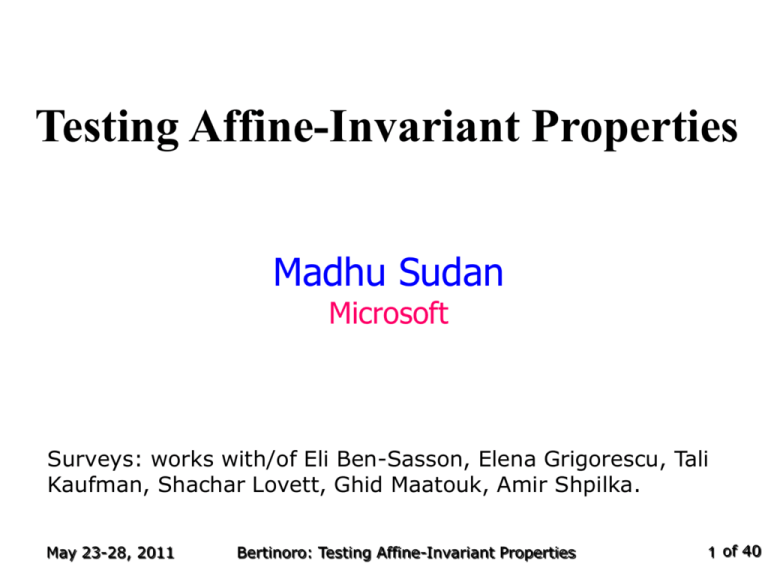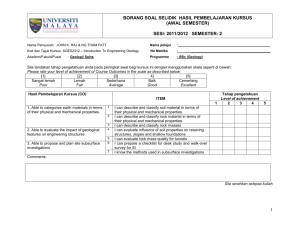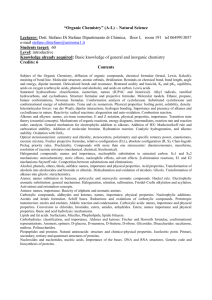Testing Affine-Invariant Properties
advertisement

Testing Affine-Invariant Properties
Madhu Sudan
Microsoft
Surveys: works with/of Eli Ben-Sasson, Elena Grigorescu, Tali
Kaufman, Shachar Lovett, Ghid Maatouk, Amir Shpilka.
May 23-28, 2011
Bertinoro: Testing Affine-Invariant Properties
1 of 40
Property Testing
… of functions from D to R:
Property P µ {D R}
Distance
δ(f,g) = Prx 2 D [f(x) ≠ g(x)]
δ(f,P) = ming 2 P [δ(f,g)]
f is ε-close to g (f ¼² g) iff δ(f,g) · ε.
Local testability:
P is (k, ε, δ)-locally testable if 9 k-query test T
f 2 P ) Tf accepts w.p. 1-ε.
δ(f,P) > δ ) Tf accepts w.p. ε.
Notes: want k(ε, δ) = O(1) for ε,δ= (1).
May 23-28, 2011
Bertinoro: Testing Affine-Invariant Properties
2 of 40
Classical Property Test: Linearity [BLR]
Does f(x+y) = f(x) + f(y), for all x, y?
Variation (Affineness):
Is f(x+y) + f(0) = f(x) + f(y) , for all x, y?
(roughly f(x) = a0 + i=1n ai xi )
Test: Pick random x,y and verify above.
Obvious: f affine ) passes test w.p. 1.
BLR Theorem: If f is δ-far from every affine
function, then it fails test w.p. Ω(δ).
Ultimate goal of talk: To understand such testing
results.
May 23-28, 2011
Bertinoro: Testing Affine-Invariant Properties
3 of 40
Affine-Invariant Properties
Domain = K = GF(qn) (field with qn elements)
Range = GF(q); q = power of prime p.
P forms F-vector space.
P invariant under affine transformations of
domain.
Affine transforms? x a.x + b, a є K*, b є K.
Invariance? f є P ) ga,b(x) = f(ax+b) є P.
“affine permutation of domain leaves P
unchanged”.
Quest: What makes affine-invariant property
testable?
May 23-28, 2011
Bertinoro: Testing Affine-Invariant Properties
4 of 40
(My) Goals
Why?
BLR test has been very useful (in PCPs, LTCs).
Other derivatives equally so (low-degree test).
Proof magical! Why did 3 (4) queries suffice?
Can we find other useful properties?
Program:
Understand the proof better (using invariance).
Get structural understanding of affine-invariant
properties, visavis local testability.
Get better codes/proofs?
May 23-28, 2011
Bertinoro: Testing Affine-Invariant Properties
5 of 40
Why’s?
Why Invariance
Natural way to abstract/unify common themes
(in property testing).
Graph properties, Boolean, Statistical etc.?
Why affine-invariance:
Abstracts linearity (affine-ness) testing.
Low-degree testing
BCH testing …
Why F-vector space?
Easier to study (gives nice structure).
Common feature (in above + in codes).
May 23-28, 2011
Bertinoro: Testing Affine-Invariant Properties
6 of 40
Contrast w. Combinatorial P.T.
R is a field F;
P is linear!
Universe:
{f:D R}
P
Must accept
P
Don’t care
Algebraic Property = Code! (usually)
May 23-28, 2011
Must reject
Bertinoro: Testing Affine-Invariant
Properties
7 of 40
Basic Implications of Linearity [BHR]
If P is linear, then:
Tester can be made non-adaptive.
Tester makes one-sided error
(f 2 P ) tester always accepts).
Motivates:
Constraints:
k-query test => constraint of size k:
value of f at ®1,… ®k constrained to lie in subspace.
Characterizations:
If non-members of P rejected with positive
probability, then P characterized by local constraints.
functions satisfying all constraints are members of P.
May 23-28, 2011
Bertinoro: Testing Affine-Invariant Properties
8 of 40
Pictorially
f = assgm’t to left
Right = constraints
1
2
3
{0000,1100,
0011,1111}
Characterization of P:
P = {f sat. all constraints}
D
May 23-28, 2011
Bertinoro: Testing Affine-Invariant Properties
9 of 40
Back to affine-invariance: More Notes
Why K F?
Very few permutations (|K|2) !!
Still “2-transitive”
Includes all properties from Fn to F that are
affine-invariant over Fn.
(Hope: Maybe find a new range of
parameters?)
Contrast with “linear-invariance” [Bhattacharyya et al.]
Linear vs. Affine.
Arbitrary P vs. F-vector space P
Linear over Fn vs. Affine over K = GF(qn).
May 23-28, 2011
Bertinoro: Testing Affine-Invariant Properties
10 of 40
Affine-invariance & testability
k-local constraint
k-characterized
k-locally testable
k-S-O-C [KS’08]
May 23-28, 2011
Bertinoro: Testing Affine-Invariant Properties
11 of 40
Goal of this talk
Definition: Single-orbit-characterization (S-O-C)
Known testable affine-invariant properties
(all S-O-C!).
Structure of Affine-invariant properties.
Non testability results
Open questions
May 23-28, 2011
Bertinoro: Testing Affine-Invariant Properties
12 of 40
Single-orbit-characterization (S-O-C)
Many common properties are given by
(Affine-)invariance
Single constraint.
Example: Affineness over GF(2)n:
Affineness is affine-invariant.
f(000000) - f(100000) ≠ f(010000) – f(110000)
S-O-C: Abstracts this notion.
Suffices for testability [Kaufman+S’08]
Unifies all known testability results!!
Nice structural properties.
May 23-28, 2011
Bertinoro: Testing Affine-Invariant Properties
13 of 40
S-O-C: Formal Definition
Constraint:
C = (®1,…,®k;V µ Fk ); ®i є K
C satisfied by f if
(f(®1),…,f(®k)) є V.
Orbit of constraint = {C o ¼ }¼, ¼ affine.
C o ¼ = (¼(®1),…,¼(®k); V).
P has k-S-O-C, if orbit(C) characterizes P.
May 23-28, 2011
Bertinoro: Testing Affine-Invariant Properties
14 of 40
Known testable properties - 0
Theorem [Kaufman-S.’08]:
If P has a k-S-O-C, then P is k-locally testable.
May 23-28, 2011
Bertinoro: Testing Affine-Invariant Properties
15 of 40
Affine-invariance & testability
k-local constraint
k-characterized
k-locally testable
k-S-O-C [KS’08]
May 23-28, 2011
Bertinoro: Testing Affine-Invariant Properties
16 of 40
Known testable properties - 0
Theorem [Kaufman-S.’08]:
If P has a k-S-O-C, then P is k-locally testable.
But who has k-S-O-C?
Affine functions:
over affine transforms of Fn
Degree d polynomials:
again, over affine transforms of Fn
May 23-28, 2011
Bertinoro: Testing Affine-Invariant Properties
17 of 40
Known testable properties - 1
Reed-Muller Property:
View domain as Fn (n-variate functions)
Parameter d.
RM(d) = n-var. polynomials of degree ≤ d.
Known to be qO(d/q)-locally testable:
Test: Test if f restricted to O(d/q)-dimensional
subspace is of degree d.
Analysis: [Kaufman-Ron]
Single-Orbit?
Yes – naturally over affine transforms of Fn.
Yes – unnaturally over K (field of size Fn).
(see appendix 1).
May 23-28, 2011
Bertinoro: Testing Affine-Invariant Properties
18 of 40
Known testable properties - 2
Sparse properties:
Parameter t
|P| ≤ |K|t
Testability:
Conditioned on “high-distance” [KaufmanLitsyn, Kaufman-S.]. (no need for aff. inv.)
Unconditionally
[Grigorescu, Kaufman, S. ], [KaufmanLovett] (for prime q).
Also S-O-C.
May 23-28, 2011
Bertinoro: Testing Affine-Invariant Properties
19 of 40
Known Testable Properties - 3
Intersections:
P1 P2 always locally testable, also S-O-C.
Sums:
P1 + P2 (= {f1 + f2 | fi є Pi})
S-O-C iff P1 and P2 are S-O-C [BGMSS’11]
Lifts [BMSS’11]
Suppose F µ L µ K.
P µ {L F} has k-S-O-C, with constraint C.
Then Lift_{L K}(P) = property characterized
by K-orbit(C).
By Definition: Lift(P) is k-S-O-C.
May 23-28, 2011
Bertinoro: Testing Affine-Invariant Properties
20 of 40
Known Testable Properties - 1
Finite combination of Lifts, Intersections, Sums of
Sparse and Reed-Muller properties.
Known: They are testable (for prime q).
Open: Are they the only testable properties?
If so, Testability ≡ Single-Orbit.
First target: n = prime:
no lifts/intersections; only need to show
that every testable property is sum of
sparse and Reed-Muller property.
May 23-28, 2011
Bertinoro: Testing Affine-Invariant Properties
21 of 40
Affine-Invariant Properties:
Structure
May 23-28, 2011
Bertinoro: Testing Affine-Invariant Properties
22 of 40
Preliminaries
Every function from K K, including K F,
is a polynomial in K[x]
So every property P = {set of polynomials}.
Is set arbitrary? Any structure?
Alternate representation:
2
n-1
q
q
q
Tr(x) = x + x + x
+…+x
Tr(x+y) = Tr(x)+Tr(y); Tr(®x) = ®Tr(x), ® є F.
Tr: K F.
Every function from K F is Tr(f) for some
polynomial f є K[x].
Any structure to these polynomials?
May 23-28, 2011
Bertinoro: Testing Affine-Invariant Properties
23 of 40
Example
F = GF(2), K = GF(2n).
Suppose P contains Tr(x11 + x3 + 1).
What other functions must P contain (to be
affine-invariant)?
Claims:
Let D = {0,1,3,5,9,11}.
Then P contains every function of the form
Tr(f), where f is supported on monomials with
degrees from D.
So Tr(x5),Tr(®x9+¯x5),Tr(x11+x5+x3+x)+1 є P.
How? Why?
May 23-28, 2011
Bertinoro: Testing Affine-Invariant Properties
24 of 40
Structure - 1
Definitions:
Deg(P) = {d | 9 f є P, with xd є supp(f)}
Fam(D) = {f: K F | supp(f) µ D}
Proposition: For affine-invariant property P
P = Fam(Deg(P)).
May 23-28, 2011
Bertinoro: Testing Affine-Invariant Properties
25 of 40
Structure - 2
Definitions:
Shift(d) = {d, q.d, q2.d, … } mod (qn-1).
D is shift-closed if Shift(D) = D.
e ≤ d : e = e0 + e1 p + …;
d = d0 + d1 p + …;
e ≤ d if ei ≤ di for all i.
Shadow(d) = {e ≤ d};
Shadow(D) = [d є D Shadow(d).
D is shadow-closed if Shadow(D) = D.
May 23-28, 2011
Bertinoro: Testing Affine-Invariant Properties
26 of 40
Structure - 3
Proposition: For every affine-invariant property P,
Deg(P) is p-shadow-closed and q-shift-closed.
(Shadowing comes from affine-transforms;
Shifts come from range being F).
Proposition: For every p-shadow-closed, q-shiftclosed family D, Fam(D) is affine-invariant and
D = Deg(Fam(D))
May 23-28, 2011
Bertinoro: Testing Affine-Invariant Properties
27 of 40
Example revisited
Tr(x11 + x3) є P
Deg(P) 11, 3 (definition of Deg)
Deg(P) 11, 9, 5, 3, 1, 0 (shadow-closure)
Deg(P) Tr(x11), Tr(x9) etc. (shift-closure).
Fam(Deg(P)) Tr(x11) etc. (definition of Fam).
P Tr(x11) (P = Fam(Deg(P)))
May 23-28, 2011
Bertinoro: Testing Affine-Invariant Properties
28 of 40
What kind of properties have k-S-O-C?
(Positive results interpreted structurally)
If propery has all degrees of q-weight at most k
then it is RM and has (qk)-S-O-C:
q-weight(d) = i di,
where d = d0 + d1 q + …
Also, if P = Fam(D) & D = Shift(S) for small
shadow-closed S, then P is k(|S|)-S-O-C.
(Alternate definition of sparsity.)
Other examples from Intersection, Sum, Lift.
May 23-28, 2011
Bertinoro: Testing Affine-Invariant Properties
29 of 40
What affine-invariant properties are not
locally testable.
Very little known.
Specific examples:
GKS08: Exists a-i property with k-local
constraint which is not k-locally characterized.
BMSS11: Exists k-locally characterized a-i
property that is not testable.
BSS’10: If wt(d) ¸ k for some d in Deg(P), then P
does not have a k-local constraint.
May 23-28, 2011
Bertinoro: Testing Affine-Invariant Properties
30 of 40
Affine-invariance & testability
[BS’10]
weight-k degrees
k-local constraint
[BMSS’11]
k-characterized
k-locally testable
[GKS’08]
May 23-28, 2011
k-S-O-C [KS’08]
Bertinoro: Testing Affine-Invariant Properties
31 of 40
Quest in lower bound
Given degree set D (shadow-closed, shift-closed)
prove it has no S-O-C.
Equivalently: Prove there are no
¸1 … ¸k є F, ®1 … ®k є K such that
i=1k ¸i ®id = 0 for every d є D.
i=1k ¸i ®id ≠ 0 for every minimal d D.
May 23-28, 2011
Bertinoro: Testing Affine-Invariant Properties
32 of 40
Pictorially
Is there a vector
(¸1,…,¸k) in its
right kernel?
M(D) =
®1d ®2d
…
®kd
Can try to prove
“NO” by proving
matrix has full rank.
Unfortunately, few
techniques to
prove non-square
matrix has high
rank.
May 23-28, 2011
Bertinoro: Testing Affine-Invariant Properties
33 of 40
Non-testable Property - 1
AKKLR (Alon,Kaufman,Krivelevich,Litsyn,Ron) Conjecture:
If a linear property is 2-transitive and has a klocal constraint then it is testable.
[GKS’08]: For every k, there exists affineinvariant property with 8-local constraint that
is not k-locally testable.
P = Fam(Shift({0,1} [ {1+2,1+22,…,1+2k})).
May 23-28, 2011
Bertinoro: Testing Affine-Invariant Properties
34 of 40
Proof (based on [BMSS’11])
F = GF(2); K = GF(2n);
Pk = Fam(Shift({0,1} [ {1 + 2i | i є {1,…,k}}))
Let Mi =
® 12 ® 22
®1
2
i
®2
i
2
…
®k2
…
®k
i
2
If Ker(Mi) = Ker(Mi+1), then Ker(Mi+2) = Ker(Mi)
Ker(Mk+1) = would accept all functions in Pk+1
So Ker(Mi) must go down at each step, implying
Rank(M_{i+1}) > Rank(M_i).
May 23-28, 2011
Bertinoro: Testing Affine-Invariant Properties
35 of 40
Stronger Counterexample
GKS counterexample:
Takes AKKLR question too literally;
Of course, a non-locally-characterizable
property can not be locally tested.
Weaker conjecture:
Every k-locally characterized affine-invariant
(2-transitive) property is locally testable.
Alas, not true: [BMSS]
May 23-28, 2011
Bertinoro: Testing Affine-Invariant Properties
36 of 40
[BMSS] CounterExample
Recall:
Every known locally characterized property
was locally testable
Every known locally testable property is S-O-C.
Need a locally characterized property which is
(provably) not S-O-C.
Idea:
Start with sparse family Pi.
Lift it to get Qi (still S-O-C).
Take intersection of superconstantly many
such properties. Q = i Qi
May 23-28, 2011
Bertinoro: Testing Affine-Invariant Properties
37 of 40
Example: Sums of S-O-C properties
Suppose D1 = Deg(P1) and D2 = Deg(P2)
Then Deg(P1 + P2) = D1 [ D2.
Suppose S-O-C of P1 is C1: f(a1) + … + f(ak) = 0;
and S-O-C of P2 is C2: f(b1) + … + f(bk) = 0.
Then every g є P1 + P2 satisfies:
i,j g(ai bj) = 0
Doesn’t yield S-O-C, but applied to random
constraints in orbit(C1), orbit(C2) does!
Proof uses wt(Deg(P1)) ≤ k.
May 23-28, 2011
Bertinoro: Testing Affine-Invariant Properties
38 of 40
Concluding
Affine-invariance gives nice umbrella to capture
algebraic property testing:
Important (historically) for PCPs, LTCs, LDCs.
Incorporates symmetry.
Would be nice to have a complete
characterization of testability of affine-invariant
properties.
Understanding (severely) lacking.
Know:
Can’t be much better than Reed-Muller.
Can they be slightly better? YES!
May 23-28, 2011
Bertinoro: Testing Affine-Invariant Properties
39 of 40
Thank You!
May 23-28, 2011
Bertinoro: Testing Affine-Invariant Properties
40 of 40

